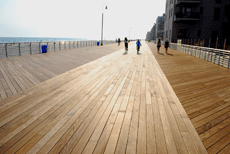
 |
 
Long Beach Is Destroying Nine Square Miles of Rainforests
 July 14, 2013 
Members of Rainforest Relief have spoken up in protest at three of Long Beachís town meetings, but the council members and City Manager are not budging. As well, Corey Klein, Long Beachís Corporate Counsel, has not complied with requests for documents the town says will prove that the wood meets their own lawís requirements. In the past, Long Beach used a small amount of ipÍ for a walkway on the townís bayside. It was suggested in 1998 that they use it for coastal boardwalk repairs. The then-City-Manager, Ed Eaton, contacted Rainforest Relief to find out if the wood was the right choice, environmentally. Rainforest Relief sent a 13-page rebuttal of propaganda supplied to the town by Timber Holdings, Ltd., a company that has been one of the largest sellers of ipÍ in the United States for decades. The town agreed with us and used an alternative material for their coastal boardwalk repairs. In 2000, we were contacted by two high school students living in Long Beach looking to help spare rainforests from destruction. We suggested they work to pass a law in Long Beach to end possible future uses of tropical hardwoods for future boardwalk renovations. The law was passed in 2001. Mr. Eaton was one of the main supporters. Hurricane Sandy pummeled the New Jersey, New York City and Long Island shore. In New Jersey, the storm demolished boardwalks in Belmar, just south of Avon, Seaside Heights, Long Branch, Sea Girt and parts of the Asbury Park and sections of the Atlantic City boardwalk. Boardwalks in The Rockaways in New York City were completely destroyed. There was also heavy damage in Long Beach. Unfortunately, Long Beach chose to move forward with ipÍ to reconstruct their entire boardwalk, formerly made of pine. This decision was supported by Senator Charles Schumer, who has lobbied FEMA, the Federal Emergency Management Agency, to reimburse Long Beach for the more-expensive wood. Avon has ordered 400,000 board feet of 2x6" ipÍ decking. In our Deep Impact report, we site numbers from a tropical logger, showing that only 38 board feet of fine export quality, four-side-clear material longer than 7' is produced from an entire ipÍ tree. Avon has ordered boards in lengths of 8, 12 and 20 feet. At an average of one ipÍ tree found per acre (76 board feet/hectare), 9 square miles of rainforests will be logged to produce the decking for Avonís boardwalk. The town of Long Beach comprises about three square miles. According to our research, this is likely the single largest one-time purchase of tropical hardwoods for a coastal boardwalk in the history of the United States. If ever there would be an enormous impact-per-person ó on Earthís climate and biodiversity ó this is it. Please donate to Rainforest Relief today to help us stop this catastrophic destruction of rainforests. To get involved, please email us. We will keep you up-to-date. Share this campaign on Facebook and please donate now. We canít stop this without your help. |
 |
 |
|||||||||||||||||
 Copyright 2013 Rainforest Relief |
||||||||||||||||||||
